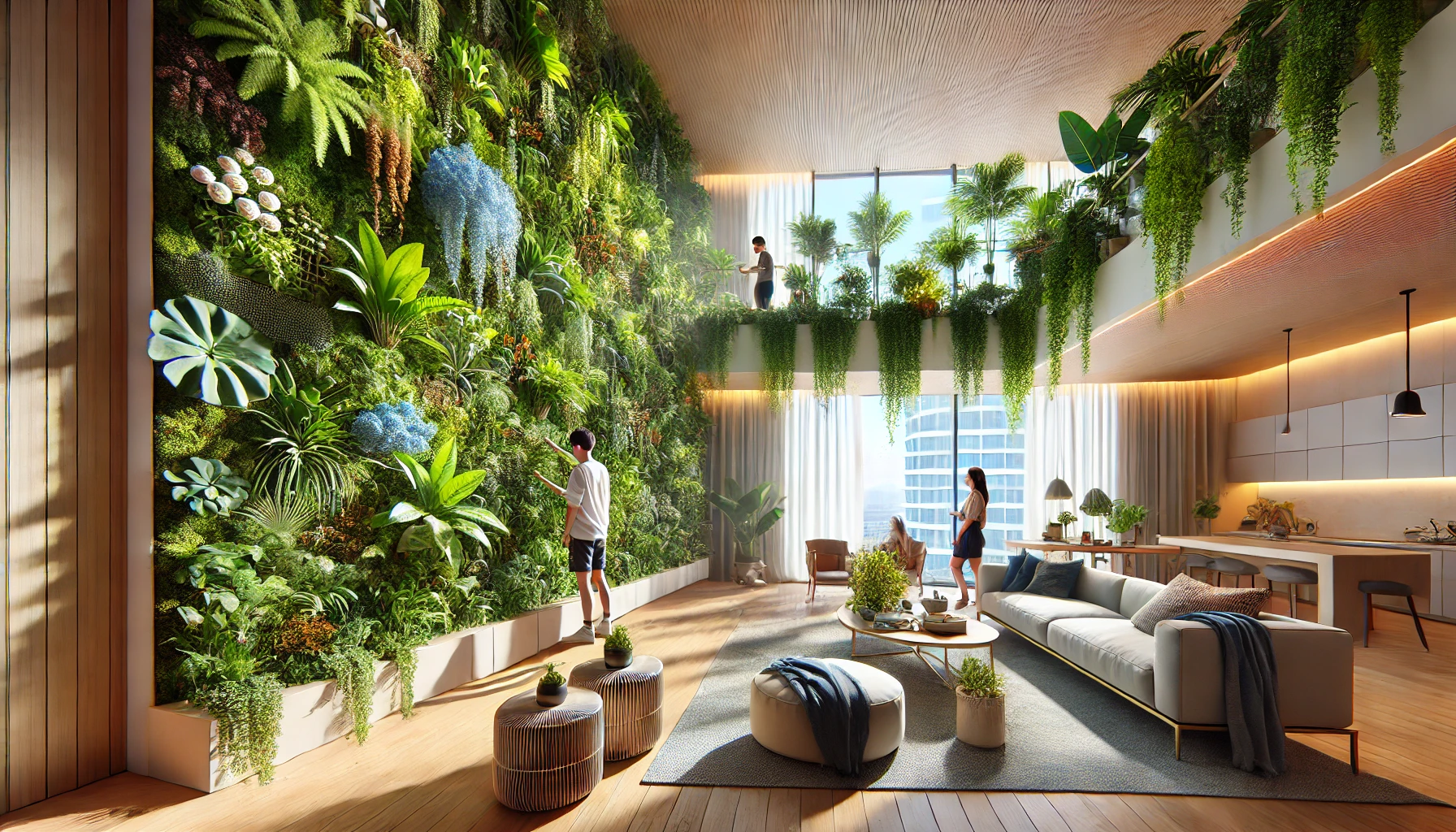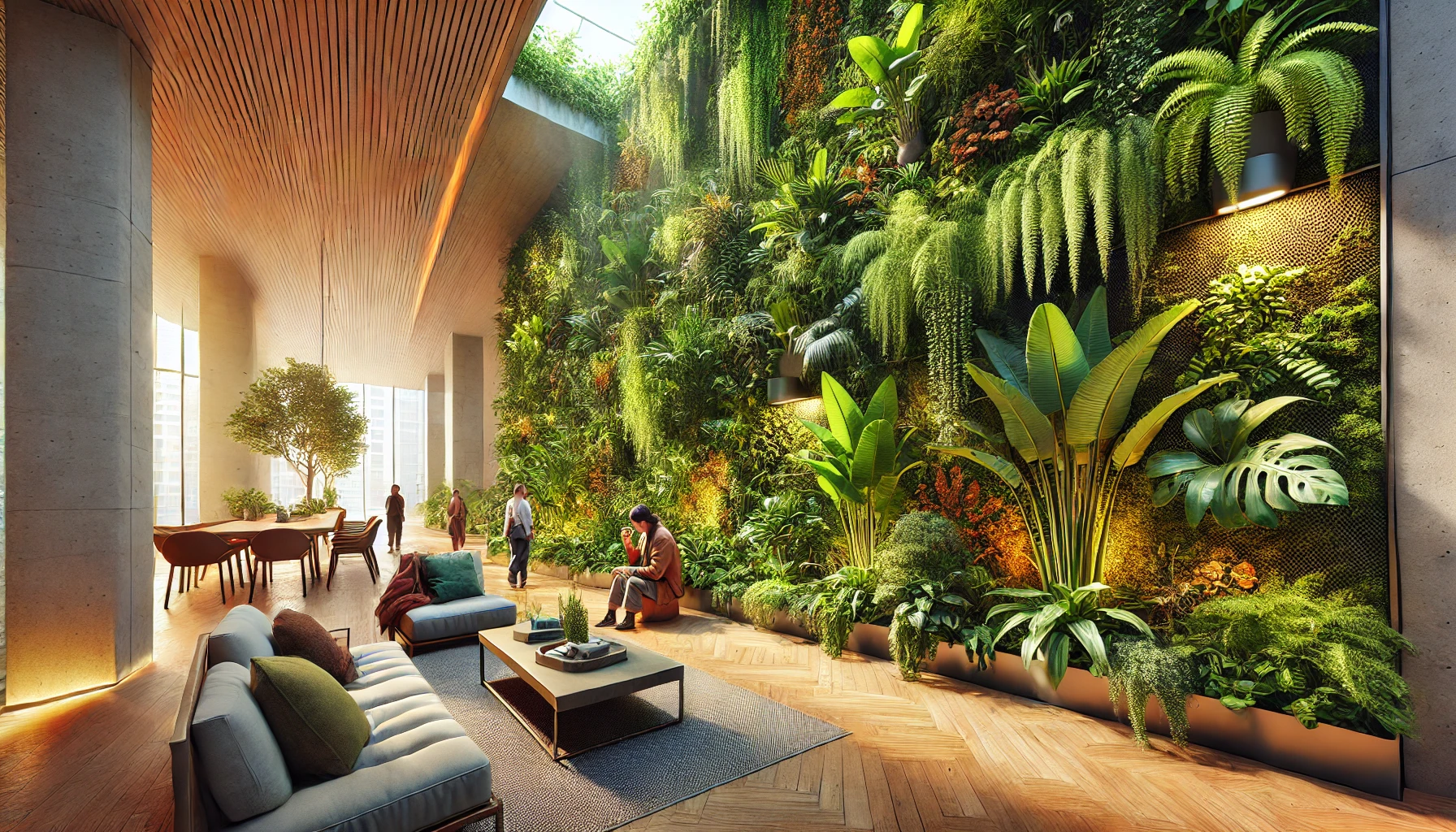An indoor living wall garden is a vertical installation of plants designed to bring greenery into indoor spaces. Unlike traditional potted plants, these walls incorporate a variety of plants grown in a structured framework that can be attached to walls.
This concept has gained immense popularity in recent years due to its ability to merge functionality with aesthetic appeal. As urbanization leads to smaller living spaces, indoor living walls offer a way to reconnect with nature while optimizing space.
Aesthetic Enhancement and Air Quality Improvement in Indoor Spaces
Indoor living walls serve as living art pieces that enhance the ambiance of any room. The lush greenery introduces an organic texture, creating a sense of tranquility and freshness.
Moreover, these walls contribute significantly to improving indoor air quality by absorbing pollutants and releasing oxygen. Studies show that certain plants can remove toxins such as formaldehyde and benzene from the air, promoting a healthier indoor environment.
The Psychological Impact of Greenery in Indoor Spaces
Incorporating greenery indoors has a profound psychological effect. Research indicates that exposure to plants can reduce stress levels, improve mood, and even enhance cognitive function.
In workplaces, living walls have been linked to increased productivity and employee satisfaction. The visual appeal combined with the soothing effect of natural elements creates a harmonious living or working environment.
Enhancing Interior Design with Living Walls
From a design perspective, living walls offer endless possibilities. They can act as striking focal points or seamlessly blend with existing decor.
With advancements in modular systems, these walls can be customized to fit various design styles, whether modern, minimalist, or eclectic.
Designers are now integrating living walls with other elements such as water features and ambient lighting to create multi-sensory experiences.
Innovative Indoor Living Wall Garden Ideas
Creative Design Ideas for Living Wall Gardens
When designing an indoor living wall, creativity knows no bounds. Homeowners and designers often incorporate geometric patterns or symmetrical layouts to achieve visually striking results.
Incorporating cascading plants, such as pothos or ferns, adds a dynamic element to the design, creating a waterfall effect of greenery.
Incorporating Vertical Edibles
For a functional twist, consider incorporating edible plants into your living wall. Vertical herb gardens featuring basil, mint, and chives not only add beauty but also provide fresh ingredients for cooking. Imagine the convenience of picking fresh herbs right off your wall while preparing meals.
Seasonal Themes and Rotations
To keep your living wall dynamic and fresh, you can introduce seasonal themes. For example, use vibrant flowers in spring, cooling greens in summer, warm-hued foliage in autumn, and winter-blooming plants to bring cheer during colder months. Rotating plants seasonally ensures that your living wall stays visually engaging and healthy.
Examples of Themed Living Walls (Herbs, Succulents, Ferns)
Themed living walls allow you to tailor your indoor garden to specific preferences. For instance:
- Herb Wall: Perfect for culinary enthusiasts, a wall filled with fresh basil, thyme, and parsley adds both flavor and aroma to your kitchen.
- Succulent Wall: Succulents offer a low-maintenance option and come in diverse shapes and colors, making them ideal for creating intricate designs.
- Fern Wall: Ferns thrive in humid conditions and create a lush, tropical atmosphere, ideal for bathrooms or meditation spaces.
Combining Themes for a Unique Look
Mixing themes can create a one-of-a-kind living wall. Combine herbs with flowering plants to add bursts of color, or integrate ferns and succulents for a blend of textures and forms. This approach not only enhances visual interest but also increases the diversity of your indoor ecosystem.
The Role of Color, Texture, and Plant Selection in Design
Strategically selecting plants with varying colors and textures elevates the visual appeal of your living wall. Contrast light and dark foliage or mix large-leaf plants with finer textures for a layered look.
Combining flowering plants with green foliage adds vibrant pops of color, creating a captivating and dynamic display.
Using Monochromatic Schemes
For a sleek and modern look, consider a monochromatic plant scheme. Use varying shades of green or focus on a single color, such as deep purple foliage paired with subtle lavender blooms. Monochromatic designs create a cohesive and sophisticated appearance.
Textural Contrasts for Depth
Textural contrast is key to creating depth in your living wall. Pairing smooth-leaf plants like philodendrons with feathery ferns or spiky succulents adds dimension and intrigue. This interplay of textures draws the eye and enhances the overall design.
Exploring the Best Indoor Living Wall Garden Kits
Overview of Top-Rated Living Wall Garden Kits Available in the Market
For those looking to simplify the process, several high-quality living wall garden kits are readily available. These kits include modular panels, irrigation systems, and mounting hardware, making them beginner-friendly.
Key Features to Consider When Choosing a Kit
When selecting a kit, key considerations include:
- Size: Ensure the kit fits your designated space.
- Irrigation System: Look for systems with built-in irrigation for hassle-free watering.
- Plant Compatibility: Choose kits that support the type of plants you wish to grow.
Advanced Features for Enhanced Functionality
Modern kits come with features like smart irrigation systems that monitor soil moisture and automate watering schedules. Some even include built-in grow lights to ensure optimal growth conditions in low-light environments.
Comparison of Different Brands Based on User Reviews and Ratings
Brands like Woolly Pocket, LiveWall, and GroVert consistently receive high praise for their durability and ease of use. Online reviews often highlight factors such as ease of installation, effectiveness of the irrigation system, and overall design appeal.
User Feedback and Insights
Reading user feedback can provide valuable insights into the performance of different kits. Look for reviews that mention long-term durability, ease of maintenance, and customer service experiences. Comparing these factors helps in making an informed purchase decision.
Step-by-Step Guide to DIY Indoor Living Wall Gardens
Essential Tools and Materials Needed for a DIY Project
Creating your own living wall requires basic tools and materials, such as:
- A wooden or metal frame
- Plant containers or pockets
- A drip irrigation system
- Mounting hardware
- Plants suited to indoor environments
Step-by-Step Instructions for Building a Simple Living Wall
- Plan Your Design: Decide on the size, shape, and layout of your wall.
- Build the Frame: Construct a sturdy frame to hold the plant containers.
- Install Irrigation: Set up a drip system to ensure consistent watering.
- Choose and Plant: Select plants based on light availability and personal preference.
- Mount the Wall: Secure the frame to your chosen wall and ensure stability.
Safety Tips for DIY Projects
- Use appropriate tools and safety gear during construction.
- Ensure the wall structure can support the weight of plants and irrigation systems.
- Test the irrigation system thoroughly to prevent leaks or overwatering.
Creative DIY Tips and Tricks to Personalize Your Living Wall
- Add decorative elements like LED lights or small sculptures.
- Incorporate hanging elements for added depth.
- Experiment with plant arrangements to create seasonal themes.
Upcycling and Eco-Friendly Ideas
Use recycled materials such as old pallets or repurposed frames to construct your living wall. Not only does this reduce waste, but it also adds a rustic and unique charm to your indoor garden.

Top Picks for the Best Indoor Living Wall Gardens
Criteria for Selecting the Best Living Wall Gardens
The best living walls combine functionality, aesthetics, and sustainability. Key criteria include:
- Ease of Maintenance: Walls with automated systems reduce upkeep.
- Plant Health: Ensure the setup promotes optimal growth conditions.
- Aesthetic Appeal: The design should complement your interior decor.
Showcase of Award-Winning and Spectacular Indoor Gardens
Award-winning installations like the Amazon Spheres Living Walls in Seattle inspire with their grand scale and biodiversity. Residential examples, such as minimalist succulent walls, show how living walls can elevate home interiors.
Unique Residential and Commercial Examples
Explore unique installations like a moss-covered wall in a modern office or a vibrant tropical garden wall in a luxury hotel lobby. These examples demonstrate how living walls can transform both private and public spaces.
Testimonials and Experiences from Indoor Garden Owners
Homeowners frequently report how their living walls transform spaces, enhancing mood and reducing stress. Testimonials often highlight the therapeutic joy of tending to a vibrant green wall.
The Power of Indoor Vertical Garden Hydroponics
Basics of Hydroponic Gardening and Its Applications in Vertical Gardens
Hydroponics is a soilless growing method where plants absorb nutrients from water-based solutions. This system suits vertical gardens due to its lightweight and clean nature.
Advantages of Hydroponics Over Traditional Soil Gardening
Hydroponic systems allow for faster plant growth and use less water than traditional methods. They also reduce the risk of pests and soil-borne diseases, ensuring healthier plants.
Innovative Hydroponic Systems for Living Walls
Modern hydroponic systems, such as Tower Garden or ZipGrow, offer compact solutions ideal for living walls. These systems are highly efficient, utilizing vertical space to grow a variety of plants, from leafy greens to flowering vines.
A Comprehensive Look at Indoor Living Wall Kits
Features of Customizable and Modular Wall Kits
Customizable kits provide flexibility in size and design, making them suitable for various room layouts. Modular systems allow users to expand their walls over time, adapting to changing needs.
Tips for Selecting the Perfect Kit for Your Home or Office
Consider factors such as lighting, space availability, and your ability to maintain the wall. Kits with integrated lighting systems are ideal for low-light environments.
Installation and Maintenance Tips for Wall Kits
- Ensure proper wall support to handle the weight of the plants and frame.
- Regularly check irrigation systems to prevent clogs.
- Prune plants as needed to maintain a neat appearance.
How to Make a Living Wall Indoors: A Detailed Tutorial
Choosing the Right Location and Light Requirements
Select a well-lit area that receives natural light or install grow lights. Avoid direct sunlight that could scorch the plants.
Selecting Plant Varieties Suitable for Indoor Environments
Indoor-friendly plants include:
- Peace Lily: Ideal for low light
- Spider Plant: Resilient and easy to care for
- Boston Fern: Perfect for adding lush greenery
Essential Care Practices for a Thriving Living Wall
- Watering: Keep the soil or medium consistently moist.
- Fertilizing: Use liquid fertilizers to provide necessary nutrients.
- Pest Control: Regularly inspect plants for pests and take action promptly.
Brightening Spaces: Indoor Wall Gardens with Grow Lights
Understanding the Role of Grow Lights in Indoor Gardening
Grow lights mimic natural sunlight, providing the necessary spectrum of light for photosynthesis. They are essential in spaces with limited natural light.
Types of Grow Lights and Their Impact on Plant Health
Common grow lights include:
- LED Lights: Energy-efficient and long-lasting
- Fluorescent Lights: Cost-effective and suitable for smaller installations
- HID Lights: High-intensity lights ideal for larger setups
Optimization and Configuration of Grow Lights for Living Walls
Position grow lights at an appropriate distance to avoid overheating plants. Use timers to ensure plants receive adequate light cycles, typically 12-16 hours daily.


I found your article on indoor living wall garden ideas inspiring and informative. The diverse range of creative concepts presented offers practical solutions for incorporating vertical greenery into various indoor spaces.
I particularly appreciated the detailed descriptions and accompanying images, which guide the implementation of your ideas.
The emphasis on enhancing aesthetic appeal while promoting well-being through indoor vertical gardens is timely and motivating. Now, I have a few questions.
How do elements such as indoor lighting, temperature, and humidity affect the success of living wall gardens? Also, can you tell me what specific plant recommendations or adaptations are suggested for indoor conditions?
Thank you for your thoughtful feedback! I’m glad you found the article inspiring. Indoor lighting, temperature, and humidity play crucial roles in maintaining a thriving living wall garden, as they directly affect plant growth. Low-light plants like pothos, ferns, and peace lilies are great for indoor spaces, while succulents require brighter light. I’ll explore these topics in more detail in an upcoming post—stay tuned!